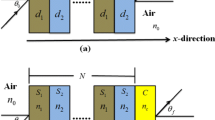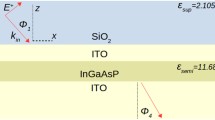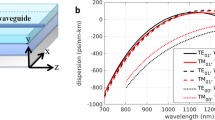Abstract
In an uncoated vapor cell, transmission spectra obtained for electromagnetically induced transparency (EIT) for D\(_2\) line of \(^{87}\)Rb show asymmetry and (or) absorption in the presence of a magnetic field. In this study, complete conversion from asymmetry/absorption to transmission is found using octadecyltrichlorosilane (OTS) as an anti-relaxation coating for a \(\Lambda\) system. The experimental results were interpreted in terms of velocity-dependent population re-distribution in the ground states induced by the coating, eventually resulting in the conversion from absorption to transmission. A simple theoretical model based on density matrix formalism is presented for qualitative interpretation of the results.








Similar content being viewed by others
References
K.J. Boller, A. Imamoğlu, S.E. Harris, Observation of electromagnetically induced transparency. Phys. Rev. Lett. 66(20), 2593 (1991)
D. Budker, M. Romalis, Optical magnetometry. Nat. Phys. 3(4), 227–234 (2007)
W.C. Griffith, S. Knappe, J. Kitching, Femtotesla atomic magnetometry in a microfabricated vapor cell. Opt. Express 18(26), 27167–27172 (2010)
R.M. Camacho, M.V. Pack, J.C. Howell, Slow light with large fractional delays by spectral hole-burning in rubidium vapor. Phys. Rev. A 74(3), 033,801 (2006)
J.D. Siverns, J. Hannegan, Q. Quraishi, Demonstration of slow light in rubidium vapor using single photons from a trapped ion. Sci. Adv. 5(10), eaav4651 (2019)
A.I. Lvovsky, B.C. Sanders, W. Tittel, Optical quantum memory. Nat. Photon. 3(12), 706–714 (2009)
K. Reim, P. Michelberger, K. Lee, J. Nunn, N. Langford, I. Walmsley, Single-photon-level quantum memory at room temperature. Phys. Rev. Lett. 107(5), 053,603 (2011)
S. Micalizio, A. Godone, F. Levi, J. Vanier, Spin-exchange frequency shift in alkali-metal-vapor cell frequency standards. Phys. Rev. A 73(3), 033,414 (2006)
J. Kitching, S. Knappe, L. Hollberg, Miniature vapor-cell atomic-frequency references. Appl. Phys. Lett. 81(3), 553–555 (2002)
A. Kumarakrishnan, U. Shim, S. Cahn, T. Sleator, Ground-state grating echoes from rb vapor at room temperature. Phys. Rev. A 58(5), 3868 (1998)
P.K. Vudyasetu, R.M. Camacho, J.C. Howell, Storage and retrieval of multimode transverse images in hot atomic rubidium vapor. Phys. Rev. Lett. 100(12), 123,903 (2008)
C. Shu, P. Chen, T.K.A. Chow, L. Zhu, Y. Xiao, M. Loy, S. Du, Subnatural-linewidth biphotons from a doppler-broadened hot atomic vapour cell. Nat. Commun. 7(1), 1–5 (2016)
M. Erhard, H. Helm, Buffer-gas effects on dark resonances: theory and experiment. Phys. Rev. A 63(4), 043,813 (2001)
S. Gozzini, P. Sartini, C. Gabbanini, A. Lucchesini, C. Marinelli, L. Moi, J. Xu, G. Alzetta, Experimental study of velocity changing collisions on coherent population trapping in sodium. Eur. Phys. J. D-Atom. Mol. Optic. Plasma Phys. 6(1), 127–131 (1999)
S. Seltzer, D. Michalak, M. Donaldson, M. Balabas, S. Barber, S. Bernasek, M.A. Bouchiat, A. Hexemer, A. Hibberd, D.J. Kimball et al., Investigation of antirelaxation coatings for alkali-metal vapor cells using surface science techniques. J. Chem. Phys. 133(14), 144,703 (2010)
H. Cheng, H.M. Wang, S.S. Zhang, P.P. Xin, J. Luo, H.P. Liu, Electromagnetically induced transparency of 87rb in a buffer gas cell with magnetic field. J. Phys. B: At. Mol. Opt. Phys. 50(9), 095,401 (2017)
Y. Xiao, Spectral line narrowing in electromagnetically induced transparency. Mod. Phys. Lett. B 23(05), 661–680 (2009)
M. Klein, M. Hohensee, D. Phillips, R. Walsworth, Electromagnetically induced transparency in paraffin-coated vapor cells. Phys. Rev. A 83(1), 013,826 (2011)
I.S. Radojičić, M. Radonjić, M.M. Lekić, Z.D. Grujić, D. Lukić, B. Jelenković, Raman-ramsey electromagnetically induced transparency in the configuration of counterpropagating pump and probe in vacuum rb cell. JOSA B 32(3), 426–430 (2015)
I.H. Subba, R.K. Singh, N. Sharma, S. Chatterjee, A. Tripathi, Understanding asymmetry in electromagnetically induced transparency for 87rb in strong transverse magnetic field. Eur. Phys. J. D 74(7), 1–9 (2020)
A. Sargsyan, D. Sarkisyan, Y. Pashayan-Leroy, C. Leroy, S. Cartaleva, A. Wilson-Gordon, M. Auzinsh, Electromagnetically induced transparency resonances inverted in magnetic field. J. Exp. Theor. Phys. 121(6), 966–975 (2015)
R.K. Singh, N. Sharma, I.H. Subba, S. Chatterjee, A. Tripathi, Competition between off-resonant and on-resonant processes in electromagnetically induced transparency in presence of magnetic field. Phys. Lett. A 416, 127,673 (2021)
R. Yahiaoui, M. Manjappa, Y.K. Srivastava, R. Singh, Active control and switching of broadband electromagnetically induced transparency in symmetric metadevices. Appl. Phys. Lett. 111(2), 021,101 (2017)
D. Brazhnikov, S. Ignatovich, A. Novokreshchenov, V. Vishnyakov, M. Skvortsov, in Quantum Information and Measurement (Optica Publishing Group, 2019), pp. T5A–78
S. Mondal, S.S. Sahoo, A.K. Mohapatra, A. Bandyopadhyay, Formation of electromagnetically induced transparency and two-photon absorption in close and open multi-level ladder systems. Opt. Commun. 472, 126,036 (2020)
M. Balabas, D. Budker, J. Kitching, P. Schwindt, J. Stalnaker, Magnetometry with millimeter-scale antirelaxation-coated alkali-metal vapor cells. JOSA B 23(6), 1001–1006 (2006)
R. Li, F.N. Baynes, A.N. Luiten, C. Perrella, Continuous high-sensitivity and high-bandwidth atomic magnetometer. Phys. Rev. Appl. 14(6), 064,067 (2020)
J. Guo, X. Feng, P. Yang, Z. Yu, L. Chen, C.H. Yuan, W. Zhang, High-performance Raman quantum memory with optimal control in room temperature atoms. Nat. Commun. 10(1), 148 (2019)
S.M. Rochester, Modeling Nonlinear Magneto-Optical Effects in Atomic Vapors (University of California, Berkeley, 2010)
M. Bhattarai, V. Bharti, V. Natarajan, A. Sargsyan, D. Sarkisyan, Study of EIT resonances in an anti-relaxation coated RB vapor cell. Phys. Lett. A 383(1), 91–96 (2019)
K. Nasyrov, S. Gozzini, A. Lucchesini, C. Marinelli, S. Gateva, S. Cartaleva, L. Marmugi, Antirelaxation coatings in coherent spectroscopy: theoretical investigation and experimental test. Phys. Rev. A 92(4), 043,803 (2015)
A. Lazoudis, T. Kirova, E. Ahmed, P. Qi, J. Huennekens, A. Lyyra, Electromagnetically induced transparency in an open v-type molecular system. Phys. Rev. A 83(6), 063,419 (2011)
I.H. Subba, A. Tripathi, Observation of electromagnetically induced absorption in 87rb d2 line in strong transverse magnetic field. J. Phys. B: At. Mol. Opt. Phys. 51(15), 155,001 (2018)
O. Mishina, M. Scherman, P. Lombardi, J. Ortalo, D. Felinto, A. Sheremet, A. Bramati, D. Kupriyanov, J. Laurat, E. Giacobino, Electromagnetically induced transparency in an inhomogeneously broadened \(\lambda\) transition with multiple excited levels. Phys. Rev. A 83(5), 053,809 (2011)
S. Chakrabarti, A. Pradhan, B. Ray, P.N. Ghosh, Velocity selective optical pumping effects and electromagnetically induced transparency for d2 transitions in rubidium. J. Phys. B: At. Mol. Opt. Phys. 38(23), 4321 (2005)
E. Breschi, G. Kazakov, C. Schori, G. Di Domenico, G. Mileti, A. Litvinov, B. Matisov, Light effects in the atomic-motion-induced Ramsey narrowing of dark resonances in wall-coated cells. Phys. Rev. A 82(6), 063,810 (2010)
I. Novikova, R.L. Walsworth, Y. Xiao, Electromagnetically induced transparency-based slow and stored light in warm atoms. Laser Photon. Rev. 6(3), 333–353 (2012)
B. Luo, H. Tang, H. Guo, Dark states in electromagnetically induced transparency controlled by a microwave field. J. Phys. B: At. Mol. Opt. Phys. 42(23), 235,505 (2009)
M. Auzinsh, D. Budker, S. Rochester, Optically Polarized Atoms: Understanding Light-Atom Interactions (Oxford University Press, 2010)
Acknowledgements
RKS would like to thank the Department of Science and Technology, India (Grant No.: DST/INSPIRE Fellowship/2018/IF180421). NS and AT would like to thank the Department of Science and Technology, India (Grant No.: EMR/2016/006150). IHS would like to thank University Grants Commission (UGC), India, for Non-NET fellowship. S.C. would like to thank the Department of Science and Technology, India (Grant No: DST/INSPIRE/04/2015/002358), and Science & Engineering Research Board (SERB), India (Grant No: SB/SRS/2020-21/51/CS).
Author information
Authors and Affiliations
Corresponding author
Ethics declarations
Conflict of interest
The authors declare no conflict of interest.
Additional information
Publisher's Note
Springer Nature remains neutral with regard to jurisdictional claims in published maps and institutional affiliations.
Appendix
Appendix
A four-level system interacting with two lasers was taken as a model. Energy levels 1 and 2 are dipole forbidden (E\(_{1}\) E\(_{2}\)). A locked weak probe excites the transitions 1\(\rightarrow\)3 and 1\(\rightarrow\)4 simultaneously, while a strong pump scans the transitions 2\(\rightarrow\)3 and 2\(\rightarrow\)4. The excited states 3 and 4 have a frequency separation of \(\Delta\). The density matrix equations for the system were taken to be of the following form:
with \(\rho _{ij}=(\rho _{ji})^*\). In the equations, \(\delta _p\)=\(\omega _{44}-\omega _p\), \(\delta\)=\(\delta _p-\delta _c\), k v is the Doppler shift, and \(\gamma _d\) is the dephasing rate due to collisions (taken to be of the order of few Hz). It should be noted that the non-zero detuning in the probe beam with respect to the excited state where the excited states are within the Doppler width of the system is important for the re-distribution discussed in the article. Usually in a three-level system, two-photon absorption processes are resolved when the conditions \(\delta _p\) \(>>\) \(\Gamma\) and \(\Omega _c>>\Omega _p\) are satisfied. However, in four-level system, the condition \(\delta _p\) \(>>\) \(\Gamma\) is not a strict one due to the presence of the nearby excited state. It can be argued that if the Doppler shift of light makes some atoms near resonant with respect to the excited state (say 4), the same class of atoms may be far resonant to the other excited state (3). Hence every class of velocity except the ones which satisfy the condition \(\Vert \delta _p-k v\Vert \ll \Gamma\) can undergo two-photon absorption. If the frequency separation between the excited states is large as compared to the Doppler width, no such re-distribution can occur (for e.g., in D\(_1\) line of \(^{87}\)Rb).
Rights and permissions
Springer Nature or its licensor (e.g. a society or other partner) holds exclusive rights to this article under a publishing agreement with the author(s) or other rightsholder(s); author self-archiving of the accepted manuscript version of this article is solely governed by the terms of such publishing agreement and applicable law.
About this article
Cite this article
Sharma, N., Singh, R.K., Subba, I.H. et al. Anti-relaxation coating-induced velocity-dependent population re-distribution in electromagnetically induced transparency. Appl. Phys. B 129, 68 (2023). https://doi.org/10.1007/s00340-023-08016-9
Received:
Accepted:
Published:
DOI: https://doi.org/10.1007/s00340-023-08016-9




